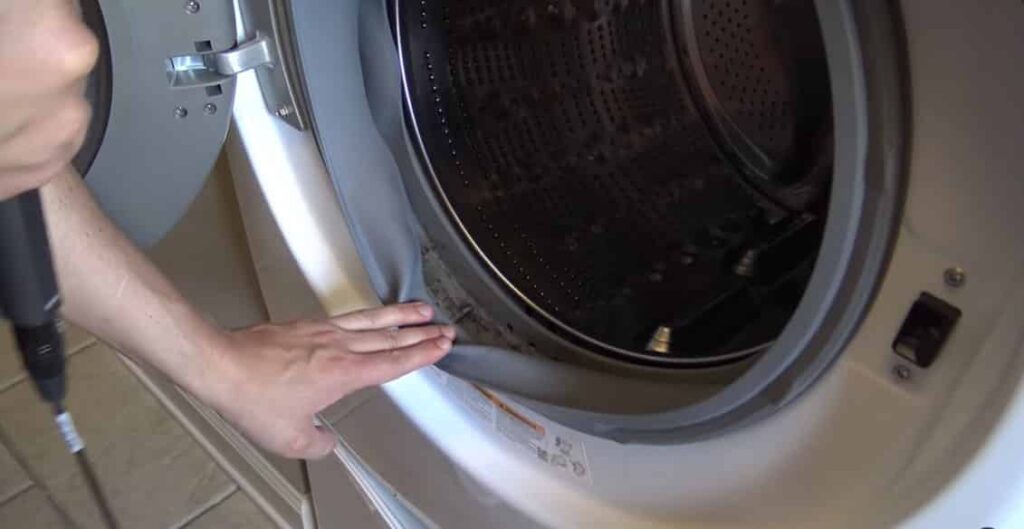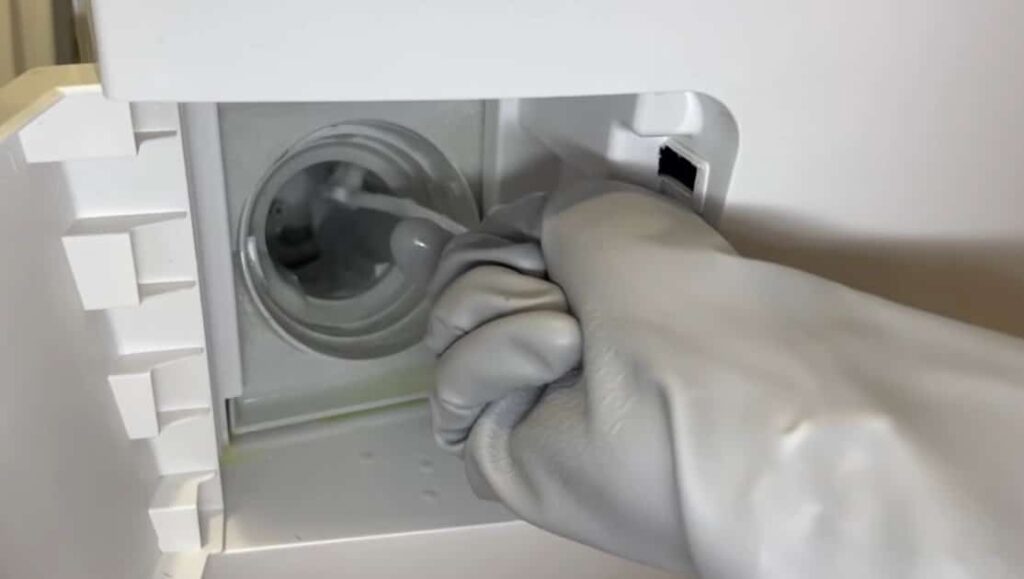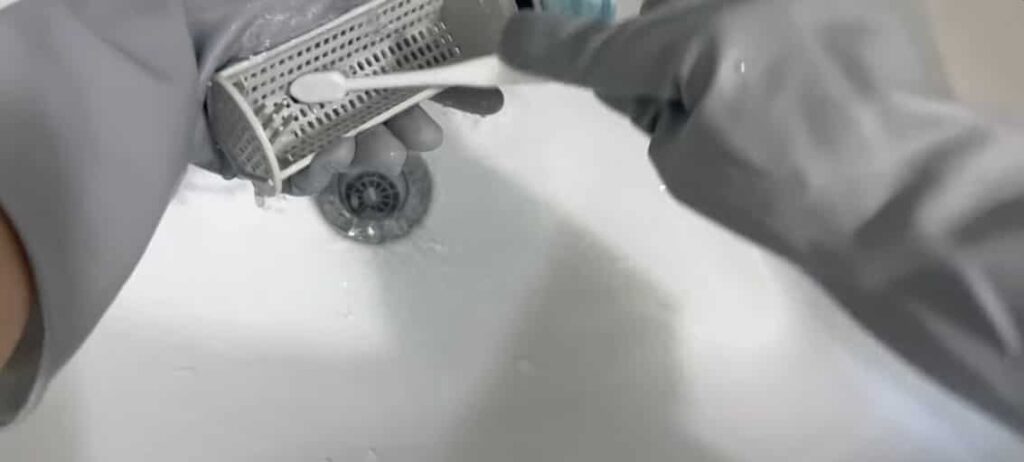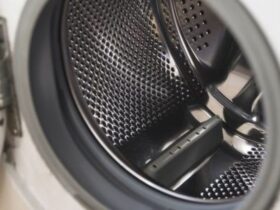Even the most reliable washing machines can develop unpleasant odors over time. This is often caused by residue buildup from detergents, softeners, and dirt, which can create a breeding ground for mold and mildew. If your portable washing machine starts to emit a foul odor, it is essential to address the problem immediately to maintain the performance of your machine and the freshness of your laundry.
Bad smell from washing machine? In this guide, we’ll walk you through the steps to effectively deodorize your washing machine and ensure it smells delicious. From routine maintenance tips to deep-cleaning procedures, you’ll find everything you need to keep your washer in top condition. Let’s find out some ways to eliminate this stench!
Table of Contents
Causes of Bad Smell From Washing Machine
Build-up of mold and mildew: Mold and mildew in your bad smell from washing machine can be a frustrating and potentially unhealthy problem. Over time, moist environments, detergent residues and organic matter create the perfect breeding ground for this pesky fungus. They can not only cause unpleasant odors but also affect the cleanliness of your clothes and even pose a health hazard to you and your family. Here’s a step-by-step guide to help you deal with the problem.
Inspect and clean the rubber gasket: Start by checking the rubber gasket or seal around the washing machine door. Mold and mildew often accumulate in gasket folds. Wipe it with equal parts water and vinegar or a mild bleach solution.

Clean the detergent dispenser: Open the detergent dispenser drawer and clean it thoroughly. Use warm, soapy water and a brush. Rinse it thoroughly before putting it back in place.
Run a cleaning cycle: Many modern bad smell from washing machine have a cleaning cycle. Check your machine’s manual to see if this feature is available. If your machine doesn’t have a specific cleaning cycle, you can run an empty hot water cycle by adding a cup of vinegar or bleach to the drum.
Clean the filter: Remove the filter and clean it thoroughly, removing any lint, debris or mold growth. Rinse it under running water and replace it safely.
Maintain proper ventilation: Keep the bad smell from washing machine door open to allow air to circulate and dry the drum and seals.
Use a high-quality detergent: Using a high-quality detergent can help prevent future mold and mildew buildup.
Regular cleaning routine: Include regular cleaning of the washing machine. Aim to clean the rubber gasket, detergent dispenser and drum once a month or more often.
Residual detergent and fabric softener: Residual detergent and fabric softener can build up in your bad smell from washing machine leading to problems such as poor wash results, unpleasant odors and even damage to your machine. Here’s how to deal with it:
Clean out dispenser drawers: Remove detergent and fabric softener dispenser drawers from your washing machine. Rinse with warm, soapy water to remove any residue or buildup. Use an old toothbrush or scrubbing brush to remove stubborn deposits.
How Do I Get Rid of The Horrible Smell in My Washing Machine?

Check for clogs: Check where the dispenser drawers are placed on the machine Sometimes, these openings can be blocked with detergent or fabric softener. Use a cloth or sponge to remove any buildup.
Run a cleaning cycle: Most modern washing machines have a cleaning cycle option. . If your machine doesn’t have a specific clean cycle, you can run an empty hot water cycle by adding a cup of vinegar or bleach to the drum. This helps dissolve any remaining detergent or fabric softener.
Reduce the amount of detergent used: Using too much detergent can contribute to residue build-up in your bad smell from washing machine. In general, using less detergent than you need can still effectively clean your clothes without leaving extra residue.
Dilute fabric softener: If you use fabric softener, dilute it with water before adding it to the dispenser. This can help prevent sticky residue from being left on your clothes and in your washing machine.
Clean the drum and seals: Wipe the inside of the washing machine’s drum and rubber seals with equal parts water and vinegar or a mild bleach solution. This helps remove any remaining detergent or fabric softener.

Regular maintenance: Incorporate regular cleaning of your washing machine to prevent residue build-up. Aim to clean the dispenser drawer and drum at least once a month or more frequently.
Accumulation of lint and debris: Lint and debris can accumulate in the washing machine over time, affecting its performance and the cleanliness of your laundry. Here’s how to deal with it:
Clean the lint filter regularly. Check the drain hoses for clogs and clean them. Run a hot water cycle with vinegar or bleach to dissolve residue. Encourage checking pockets before washing to avoid debris. Consider using lint-catching devices on the machine. Periodically wipe the drum to remove any buildup. Avoid overloading the machine to ensure proper washing.
By following these steps, you’ll maintain a clean bad smell from washing machine and ensure your clothes get fresher with every wash.
Hard water mineral deposits: Dealing with hard water mineral deposits in your washing machine can help maintain its performance and prolong its life. Here’s how to fix this problem:
Clean the detergent dispenser: Soak in a solution of equal parts water and vinegar to remove mineral deposits. Scrub any remaining residue thoroughly with a brush or sponge before rinsing thoroughly.
Clean the drum and seals: Wipe the inside of the washing machine’s drum and rubber seals with a cloth soaked in vinegar. This will help dissolve the accumulated dirt.
Descale the machine: Run an empty hot water cycle with vinegar or a descaling agent to remove accumulated debris from the machine’s inner s.
Use a water softener: Consider installing a water softener to treat the hard water supply in your washing machine. This will help prevent debris from building up in the machine and on your clothes.
Adjust detergent usage: Hard water requires more detergent to clean clothes effectively. Follow the detergent usage based on the hardness of your water supply. Using too much detergent can cause excess suds and residue to accumulate.
Regular maintenance: Incorporate regular cleaning and maintenance of your washing machine into your routine to prevent debris build-up. Clean the drum, seal, and dispenser drawer once a month or more frequently as needed.
Inspect the water inlet filter: Check the water inlet filter for any blockage caused by debris build-up in your bad smell from washing machine. Clean or replace the filter to ensure proper water flow to the machine.

By following these steps and implementing preventative measures, you can effectively manage hard water mineral deposits in your washing machine, keep it running smoothly, and keep your laundry clean and fresh.
Preventive Maintenance
Washing machine work preventive maintenance ensures optimal performance, preventing problems such as clogging, leakage, and mold. Regular cleaning, inspection, and proper usage practices prolong the life of your appliance, saving you time and money.
Regular cleaning routines: Establishing a regular cleaning routine is essential to ensure the performance and longevity of your bad smell from washing machine. Here are some details to include in your routine. Clean lint and debris from the lint filter after each wash

Wipe the drum: After finishing your laundry, wipe the inside of the drum with a damp cloth to remove any residue or dirt build-up.
Clean the door seal: Check the door seal for any signs of mold or cracks and wipe it with a mixture of water and vinegar or a mild detergent. Be sure to dry the seal thoroughly to prevent moisture build-up.
Run a cleaning cycle: Periodically run a cleaning cycle in the washing machine using a mixture of cleaner or vinegar and baking soda. This helps remove any lingering odors and keeps the interior of the machine clean.


Clean the exterior: Wipe the exterior of the bad smell from the washing machine with a damp cloth to remove dust and dirt. Pay close attention to the control knobs, buttons, and detergent dispenser tray.
By incorporating these details into your regular cleaning routine, you can keep your washing machine running efficiently and effectively for years to come.
Proper ventilation after each use: Proper ventilation after the use of your washing machine is essential to prevent mold and mildew build-up. Here are some details to ensure adequate ventilation.
Keep the door open: After each laundry cycle, leave the washing machine door open for a few hours to allow air to circulate inside the drum. This helps to dry out any moisture and prevent the growth of mold and mildew.
Empty the detergent dispenser: If your bad smell from washing machine has a detergent dispenser tray, remove it after use and let it air dry. This prevents any residual moisture or detergent from accumulating and causing odors or mold growth.


Pull out the drum: Pull out the drum of the bad smell from the washing machine slightly to allow air to reach the inside of the machine. It helps absorb moisture from the inside.
Keep the laundry room well-ventilated: Make sure your laundry room is adequately ventilated so that moisture can dissipate effectively. You can achieve this by opening windows or using exhaust fans to promote airflow.
By following these details and allowing for proper ventilation after each use, you can maintain a clean and odor-free washing machine while preventing the growth of mold and mildew.
Using HE detergent: Using high-efficiency (HE) detergent in your bad smell from washing machine is important for optimal cleaning and maintenance. Here are some details to consider:
Formulation: HE detergents are specially formulated to work with high-efficiency washing machines, which use less water than conventional models. They are designed to produce less suds, which helps prevent residue buildup and ensures thorough rinsing.
Dosage: Follow the manufacturer’s instructions for the correct dosage of HE detergent based on the size of your load and soil level. Using too much detergent can result in excessive suds while using too little can result in insufficient cleaning.
HE symbol: Look for the HE symbol on detergent packaging to ensure it is compatible with your high-efficiency bad smell from the washing machine. Using non-HE detergents in an HE machine can cause excessive siding and possible damage to the machine.


Types: HE detergents come in different forms including liquid, powder, and pods. Choose the type that works best for your preferences and washing machine needs.
Storage: Store in a cool, dry place away from direct sunlight to maintain the effectiveness of HE detergent. Avoid storing it for extended periods after the expiry date.
By paying attention to these details and using HE detergent correctly, you can ensure optimal cleaning performance and prolong the life of your high-efficiency washing machine.
Cleaning the detergent drawer and filter: Cleaning your bad smell from the washing machine detergent drawer and filter is essential to maintain its performance and prevent unpleasant odors.
Is Bleach or Vinegar Better To Clean a Washing Machine?
Remove the detergent drawer from your bad smell from washing machine. Most drawers can be easily removed by pulling firmly. Wash the detergent drawer under running water to remove any detergent residue or build-up.
Use an old toothbrush or a small brush to scrub the drawer areas, especially around the corners and crevices where detergent accumulates. If there are stubborn stains or residue, you can soak the detergent drawer in a solution of warm water and mild detergent for a few minutes before scrubbing.
Rinse the detergent drawer thoroughly to ensure all soap and debris is removed. Allow the detergent drawer to dry completely before reinserting it into the bad smell from washing machine.

Cleaning The Filter
Locate the filter on your bad smell from washing machine. It is usually located on the underside of the machine behind a small access panel or flap. Open the access panel or flap to access the filter.
Place a towel or shallow tray under the filter area to catch any water that may spill during the cleaning process. Carefully twist or pull the filter. Be prepared to drain some water, so keep your towel or tray handy.
Once removed, rinse the filter under running water to remove any lint, debris, or residue. Use a soft brush or cloth to gently scrub the filter as needed, especially if there is a stubborn build-up. Inspect the filter for any damage.
Once cleaned, reinsert the filter into its housing and secure properly. Close the access panel or flap securely.
Regularly cleaning your washing machine detergent drawer and filter helps maintain its performance and prevents clogs and odors. If you use your washing machine a lot, aim to clean it at least once a month or more often.
Cleaning Specific Parts
Cleaning certain parts of the bad smell from washing machine is important to maintain its performance and prolong its life.
Cleaning the rubber door seal:
Mix some water and white vinegar in a spray bottle. Spray the solution on the seal, focusing on mold or mold stains. Scrub gently with a soft brush. Clean with a damp cloth. Dry thoroughly with a dry cloth. Leave the door open after each use to prevent future mold growth.
Scrubbing the drum interior:
Mix white vinegar or baking soda with hot water. Pour the solution into the drum. Use a cloth or sponge to scrub the interior. Clean with a damp cloth. Run a wash cycle to remove residue.
Flushing the drain hose
Turn off and unplug the bad smell from washing machine. Locate the drain hose on the back of the machine. Remove the hose from the drain pipe or standpipe.

Flush the hose with water to remove any debris. Reattach the hose securely. Plug in the machine and run a short wash cycle to ensure proper drainage.
Cleaning the lint trap: Cleaning the lint trap in your bad smell from washing machine involves removing accumulated lint and debris to maintain its performance and prevent potential hazards. This simple task can be done by locating the lint trap, cleaning it thoroughly, checking for damage, and reassembling it. Regular cleaning ensures that your washing machine runs smoothly and efficiently.
DIY remedies and innovative approaches: Keep your bad smell from washing machine in top condition. Try using vinegar rinses, baking soda scrubs, or citric acid cleanses to remove odors and odors. Upgrade with reusable lint filters and use natural fabric softeners for lighter washes. Perform regular maintenance. Adjusting the water temperature can also increase its lifespan and effectiveness.
Common pitfalls to avoid in odor removal: To prevent odor build-up in your washing machine, avoid neglecting the lint trap, skipping regular cleanings, overusing detergent, keeping the door closed, and using excessively hot water.

Conclusion
In conclusion, maintaining a fresh and clean bad smell from washing machine is essential to ensuring your laundry smells as it should – fresh and clean. Here are the key steps to remove and prevent bad breath from you
Make a habit of regularly cleaning detergent drawers, door seals and drums. Use a damp cloth and mild detergent to wipe these areas and remove any residue or mold build-up.
Run an empty wash cycle with hot water, add 2 cups of white vinegar to the drum. Follow this with a second cycle using 1/2 cup of baking soda. It helps to remove odors and keep the machine clean.
After each wash, leave the door and detergent drawer slightly ajar to allow for air circulation. It reduces moisture inside the machine, preventing the growth of mold and mildew.
A clogged filter can cause foul odors. Check your bad smell from washing machine manual for instructions on regularly cleaning the filter to keep it free of lint and debris.
Choose high-efficiency (HE) detergents designed for your bad smell from washing machine. Using too much detergent or the wrong type can create a residue that causes odors.
By incorporating these practices into your routine, you can effectively remove odors from your washing machine and ensure it works efficiently. A fresh washing machine means fresh clothes and a more pleasant laundry experience.
Frequently Asked Questions
Q. How can I stop my washing smelling?
A. pop a cupful of white vinegar into the bad smell from washing machine drum along with your laundry.
Q. How do you get rid of bad smells after washing clothes?
A. white vinegar, baking soda, or essential oils.
Q. Where to put vinegar in a washing machine?
A. The fabric softener dispenser.
Q. What is super clean in the washing machine?
A. It first removes dirt from between fibers, then from the fabric surface, and finally lifts stains and dirt completely from the clothes.
Q. What is the best hack for cleaning a washing machine?
A. Set your bad smell from washing machine to the highest and hottest water setting. Add four cups of white vinegar, and start a cycle. Once the washing machine is filled up and barely started, pause it and allow the water and white vinegar to soak the drum for an hour.













Leave a Reply